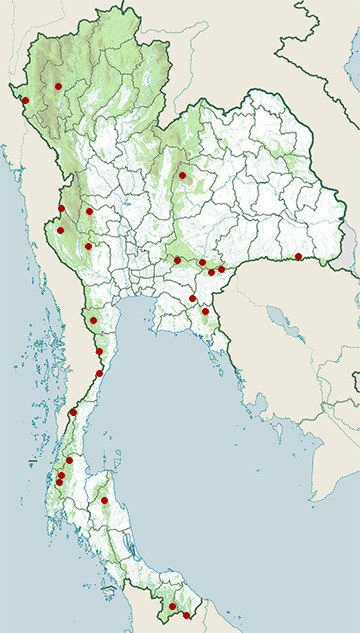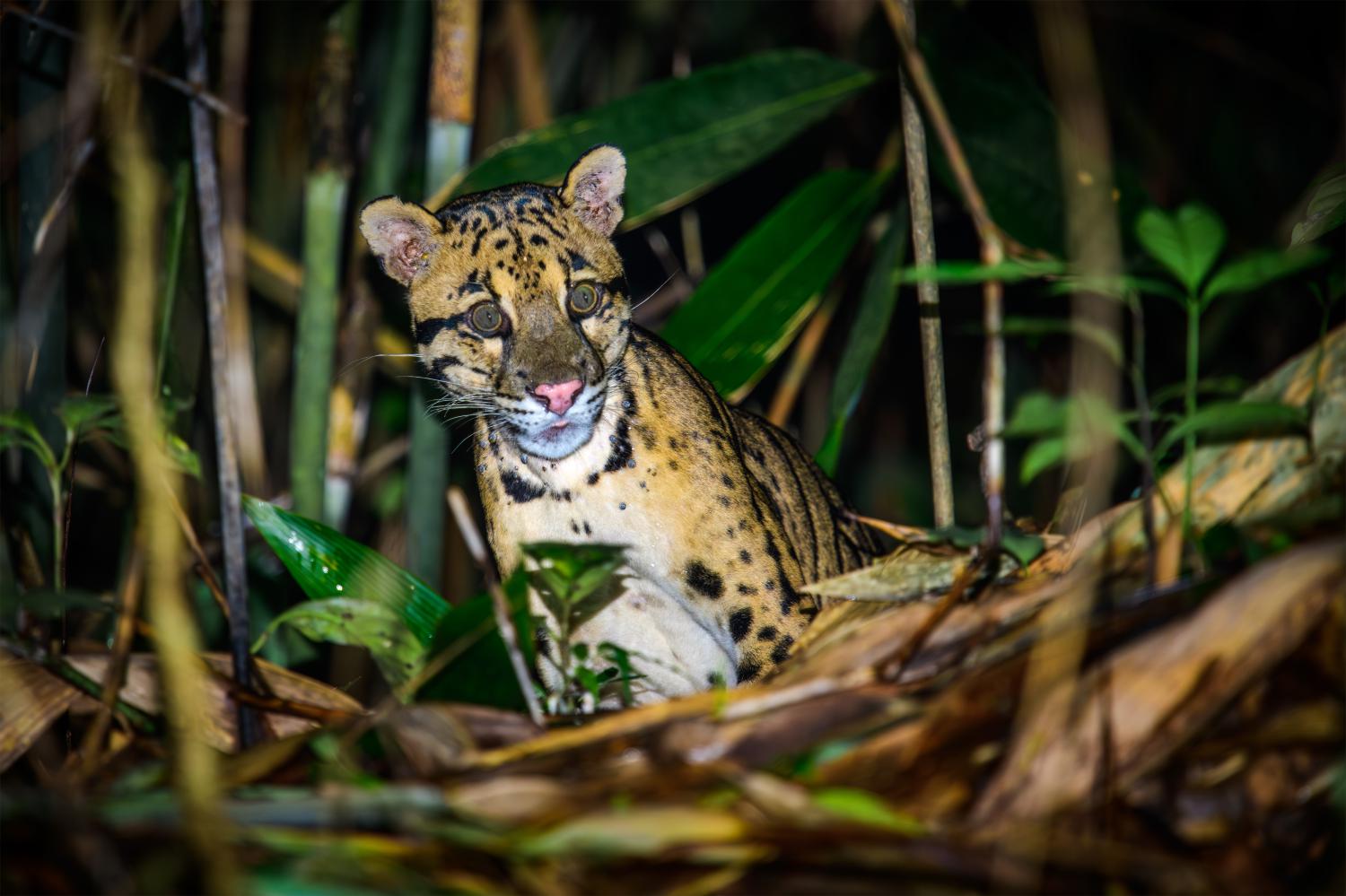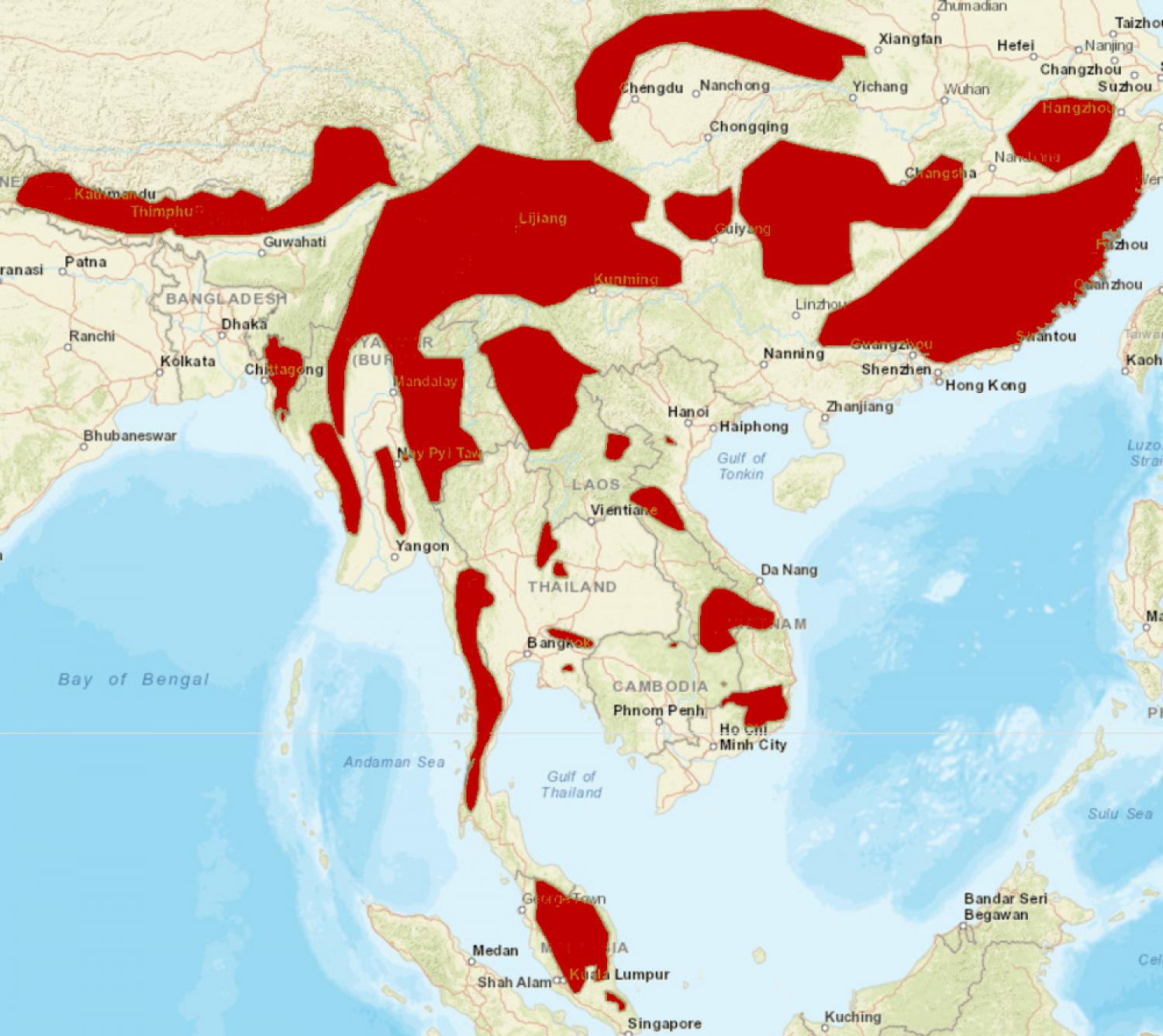Species of Thailand
Clouded leopard
Neofelis nebulosa
(Edward Griffith, 1821)
In Thai: เสือลายเมฆ
The clouded leopard (Neofelis nebulosa) is a wild cat inhabiting dense forests from the foothills of the Himalayas through mainland Southeast Asia into southern China. The first clouded leopard known to science was brought to London from China in the early 19th century and described in 1821. It has large dusky-grey blotches and irregular spots and stripes forming a clouded pattern. Its head-and-body length ranges from 68.6 to 108 cm with a 61 to 91 cm long tail. It uses its tail for balancing when moving in trees and is able to climb down vertical tree trunks head first. It rests in trees during the day and hunts by night on the forest floor.
The clouded leopard is the first cat that genetically diverged 9.32 to 4.47 million years ago from the common ancestor of the Felidae. Several million years ago, it reached Sundaland, where it diverged 2.0–0.93 million years ago to a different species, the Sunda clouded leopard (N. diardi).
Today, the clouded leopard is locally extinct in Singapore and Taiwan. Its total population is suspected to be fewer than 10, 000 mature individuals, with a decreasing population trend, and no single population numbering more than 1, 000 adults. It is therefore listed as Vulnerable on the IUCN Red List since 2008. The population is threatened by large–scale deforestation and commercial poaching for the wildlife trade. Its body parts are offered for decoration and clothing, though it is legally protected in most range countries.
The clouded leopard has been kept in zoological gardens since the early 20th century. Captive breeding programs were initiated in the 1980s. In captivity, the clouded leopard has an average lifespan of 11 years.
Taxonomy and phylogeny
Felis nebulosa was proposed by Edward Griffith in 1821 who first described a skin of a clouded leopard that was brought alive from Canton Province in China to the menagerie at Exeter Exchange in London.
Felis macrosceloides proposed by Brian Houghton Hodgson in 1841 was a clouded leopard specimen from Nepal.
Felis brachyura proposed by Robert Swinhoe in 1862 was a clouded leopard skin from Taiwan.
The generic name Neofelis was proposed by John Edward Gray in 1867 who subordinated all three to this genus.
At present, N. nebulosa is considered a monotypic species due to lack of evidence for subspeciation.
Felis diardi proposed by Georges Cuvier in 1823 was based on a clouded leopard skin from Java.
It was considered a clouded leopard subspecies by Reginald Innes Pocock in 1917. In 2006, it was identified as a distinct Neofelis species, the Sunda clouded leopard.
Phylogeny
Skulls of clouded leopard and Panthera species were analysed morphologically in the 1960s. Results indicate that the clouded leopard forms an evolutionary link between the Pantherinae and the Felinae.
Phylogenetic analysis of the nuclear DNA in tissue samples from all Felidae species revealed that the evolutionary radiation of the Felidae began in the Miocene around in Asia. Analysis of mitochondrial DNA of all Felidae species indicates a radiation at .
The clouded leopard is estimated to have been the first cat that genetically diverged from the common ancestor of the pantherine species , based on analysis of their nuclear DNA.
Genetic analysis of hair samples of the two Neofelis species indicates that they diverged 2.0–0.93 million years ago. The clouded leopard from mainland Asia reached Borneo and Sumatra via a now submerged land bridge several million years ago.
Characteristics
The clouded leopard's fur is of a dark grey or ochreous ground-color, often largely obliterated by black and dark dusky-grey blotched pattern. There are black spots on the head, and the ears are black. Partly fused or broken-up stripes run from the corner of the eyes over the cheek, from the corner of the mouth to the neck, and along the nape to the shoulders. Elongated blotches continue down the spine and form a single median stripe on the loins. Two large blotches of dark dusky-grey hair on the side of the shoulders are each emphasized posteriorly by a dark stripe, which passes on to the foreleg and breaks up into irregular spots. The flanks are marked by dark dusky-grey irregular blotches bordered behind by long, oblique, irregularly curved or looped stripes. These blotches yielding the clouded pattern suggest the English name of the cat. The underparts and legs are spotted, and the tail is marked by large, irregular, paired spots. Its legs are short and stout, and paws broad. Females are slightly smaller than males.
Its hyoid bone is ossified, making it possible to purr. Its pupils contract into vertical slits. Irises are brownish yellow to grayish green. Melanistic clouded leopards are uncommon. It has rather short limbs compared to the other big cats. Its hind limbs are longer than its front limbs to allow for increased jumping and leaping capabilities. Its ulnae and radii are not fused, which also contributes to a greater range of motion when climbing trees and stalking prey. Clouded leopards weigh between 11.5 and 23 kg. Females vary in head-to-body length from 68.6 to 94 cm, with a tail 61 to 82 cm long. Males are larger at 81 to 108 cm with a tail 74 to 91 cm long.
Its shoulder height varies from 50 to 55 cm.
Its skull is long and low with strong occipital and sagittal crests. The canine teeth are exceptionally long, the upper being about three times as long as the basal width of the socket. The first premolar is usually absent. The upper pair of canines measure 4 cm or longer.
It has a bite force quotient at the canine tip of 122.4.
The clouded leopard is often referred to as a "modern-day sabre-tooth" because it has the largest canines in proportion to its body size.
Distribution and habitat
The clouded leopard occurs from the Himalayan foothills in Nepal, Bhutan and India to Myanmar, southeastern Bangladesh, Thailand, Peninsular Malaysia, to south of the Yangtze River in China. It is regionally extinct in Singapore and Taiwan.
In Nepal, the clouded leopard was thought to be extinct since the late 1860s. But in 1987 and 1988, four individuals were found in the central part of the country, close to Chitwan National Park and in Pokhara Valley. These findings extended the known range westward, suggesting it is able to survive and breed in degraded woodlands that previously harboured moist subtropical semideciduous forest. Since then, individuals have been recorded in Shivapuri Nagarjun National Park and in Annapurna Conservation Area.
In India, it occurs in Sikkim, northern West Bengal, Meghalaya subtropical forests, Tripura, Mizoram, Manipur, Assam, Nagaland and Arunachal Pradesh. In Pakke Tiger Reserve, a clouded leopard was photographed for the first time in India. In Sikkim, clouded leopards were camera trapped at elevations of 2500 - 3720 m between April 2008 and May 2010 in the Khangchendzonga Biosphere Reserve. In Manas National Park, 16 individuals were recorded during a survey in November 2010 to February 2011. Between January 2013 and March 2018, clouded leopards were also recorded in Dampa Tiger Reserve, Eaglenest Wildlife Sanctuary and Singchung-Bugun Village Community Reserve, in Meghalaya's Nongkhyllem National Park and Balpakram-Baghmara landscape.
In Bhutan, it was recorded in Royal Manas National Park, Jigme Singye Wangchuck National Park, Phibsoo Wildlife Sanctuary, Jigme Dorji National Park, Phrumsengla National Park, Bumdeling Wildlife Sanctuary, and several non-protected areas.
In Bangladesh, a few clouded leopards were sighted in the Chittagong Hill Tracts in 2009.
In Myanmar, it was recorded by camera traps for the first time in the hill forests of Karen State in 2015.
In Thailand, it inhabits relatively open, dry tropical forest in Huai Kha Khaeng Wildlife Sanctuary and closed-forest habitats in Khao Yai National Park.
In Laos, it was recorded in Nam Et-Phou Louey National Protected Area in dry evergreen and semi-evergreen forests.
In Cambodia, it was recorded in deciduous dipterocarp forest in Phnom Prich Wildlife Sanctuary between 2008 and 2009, and in Central Cardamom Mountains National Park, Southern Cardamom National Park, Botum Sakor National Park and Phnom Samkos Wildlife Sanctuary between 2012 and 2016.
In Peninsular Malaysia, it was recorded in Taman Negara National Park, Ulu Muda Forest, Pasoh Forest Reserve, Royal Belum State Park, Temengor Forest Reserve and in a few linkages between 2009 and 2015.
The last confirmed record of a Formosan clouded leopard dates to 1989, when the skin of a young individual was found in the Taroko area. It was not recorded during an extensive camera trapping survey conducted from 1997 to 2012 in more than 1, 450 sites inside and outside Taiwanese protected areas.
Behaviour and ecology
The clouded leopard is a solitary cat. Early accounts depict it as a rare, secretive, arboreal, and nocturnal inhabitant of dense primary forest.
It is one of the most talented climbers among the cats. Captive clouded leopards have been observed to climb down vertical tree trunks head first, and hang on to branches with their hind paws bent around branchings of tree limbs. They are capable of supination and can even hang down from branches only by bending their hind paws and their tail around them. When jumping down, they keep hanging on to a branch this way until the last moment. They can climb on horizontal branches with their back to the ground, and in this position make short jumps forward. When balancing on thin branches, they use their long tails to steer. They can easily jump up to 1.2 m high.
They use trees as daytime rest sites, but also spend time on the ground when hunting at night. Captive clouded leopards have been observed to scent mark by spraying urine and rubbing their heads on prominent objects.
Their vocalisations include a short high-pitched meow call, a loud crying call, both emitted when a cat is trying to locate another one over a long or short distance; they prusten and raise their muzzle when meeting each other in a friendly manner; when aggressive, they growl with a low-pitched sound and hiss with exposed teeth and wrinkled nose.
Radio-collared clouded leopards were foremost active by night but also showed crepuscular activity peaks.
Clouded leopards recorded in northeast India were most active in the late evening after sunset.
Home ranges have only been estimated in Thailand:
- Four individuals were radio-collared in Phu Khieo Wildlife Sanctuary from April 2000 to February 2003. Home ranges of two females were 25.7 km2 and 22.9 km2, and of two males 29.7 km2 and 49.1 km2.
- Two individuals were radio-collared during a study from 1997 to 1999 in the Khao Yai National Park. The home range of one female was 39.4 km2, of the one male 42 km2. Both individuals had a core area of 2.9 km2.
Hunting and diet
When hunting, the clouded leopard stalks its prey or wait for the prey to come to them. After making and feeding on a kill, it usually retreats into trees to digest and rest. Its prey includes both arboreal and terrestrial vertebrates.
Pocock presumed that it is adapted for preying upon herbivorous mammals of considerable bulk because of its powerful build, long canines and the deep penetration of its bites. In Thailand, clouded leopards have been observed preying on southern pig-tailed macaque (Macaca nemestrina), Indian hog deer (Hyelaphus porcinus), Bengal slow loris (Nycticebus bengalensis), Asiatic brush-tailed porcupine (Atherurus macrourus), Malayan pangolin (Manis javanica) and Berdmore's ground squirrel (Menetes berdmorei). Known prey species in China include barking deer (Muntiacus) and pheasants.
In northern Peninsular Malaysia, a male clouded leopard was photographed while carrying a binturong (Arctictis binturong) in its jaws.
Reproduction
Both males and females average 26 months at first reproduction. Mating usually occurs between December and March. Males tend to be very aggressive during sexual encounters, and tend to bite the female on the neck during courtship, which occasionally kills the female. With this in mind, male and female compatibility has been deemed extremely important when attempting breeding in captivity. The pair mates multiple times over the course of several days. The male grasps the female by the neck, and the female responds with vocalization that encourages the male to continue. The male then leaves, and is not involved in raising the kittens. Estrus lasts six days on average, estrous cycle averages 30 days. After a gestation period of 93 ± 6 days, females give birth to a litter of one to five, mostly three cubs.
Initially, the young are blind and helpless, much like the young of many other cats, and weigh from 140 to 280 g. Unlike adults, the kittens' spots are "solid" — completely dark, rather than dark rings. The young can see within about 10 days of birth, are active within five weeks, and are fully weaned at around three months of age. They attain the adult coat pattern at around six months, and become independent after around 10 months. Females are able to bear one litter each year.
In captivity, they have an average lifespan of 11 years.
One individual has lived to be almost 17 years old.
Generation length of the clouded leopard is about seven years.
Threats
Many of the remaining forest areas are too small to ensure the long-term persistence of clouded leopard populations. They are threatened by habitat loss following large–scale deforestation and commercial poaching for the wildlife trade. Skins, claws, and teeth are offered for decoration and clothing, bones and meat as substitute for tiger in traditional Asian medicines and tonics, and live animals for the pet trade. Few poaching incidents have been documented, but all range states are thought to have some degree of commercial poaching. In recent years, substantial domestic markets existed in Indonesia, Myanmar, and Vietnam.
In Myanmar, 301 body parts of at least 279 clouded leopards, mostly skins and skeletons, were observed in four markets surveyed between 1991 and 2006. Three of the surveyed markets are situated on international borders with China and Thailand, and cater to international buyers, although clouded leopards are completely protected under Myanmar's national legislation. Effective implementation and enforcement of CITES is considered inadequate.
Conservation
Neofelis nebulosa is listed in CITES Appendix I and protected over most of its range. Hunting is banned in Bangladesh, China, India, Malaysia, Myanmar, Nepal, Taiwan, Thailand, and Vietnam. It is not legally protected outside Bhutan's protected areas. Hunting is regulated in Laos. No information about its protection status is available from Cambodia. These bans, however, are poorly enforced in India, Malaysia, and Thailand.
In the United States, the clouded leopard is listed as endangered under the Endangered Species Act, further prohibiting trade in the animals or any parts or products made from them.
International Clouded Leopard Day is celebrated each year on 4 August since 2018. Zoos and conservation organisations all over the world celebrate this day.
In culture
The Rukai people of Taiwan considered the hunting of clouded leopards a taboo. It is the state animal of the Indian state of Meghalaya. In the 1970s, the print of Rama Samaraweera's painting Clouded leopard was a best-seller in the USA.
This article uses material from Wikipedia released under the Creative Commons Attribution-Share-Alike Licence 3.0. Eventual photos shown in this page may or may not be from Wikipedia, please see the license details for photos in photo by-lines.
Scientific classification
- Kingdom
- Animalia
- Phylum
- Chordata
- Class
- Mammalia
- Order
- Carnivora
- Family
- Felidae
- Genus
- Neofelis
- Species
- Neofelis nebulosa
Common names
- German: Nebelparder
- English:
- Clouded leopard
- Mainland clouded leopard
- Indochinese clouded leopard
- Spanish:
- Pantera del Himalaya
- Pantera longibanda
- Pantera nebulosa
- French:
- Panthère nébuleuse
- Panthère longibande
- Italian: Leopardo nebuloso
- Dutch: Nevelpanter
- Russian: Дымчатый леопард
- Swedish: Trädleopard
- Thai: เสือลายเมฆ
Subspecies
Neofelis nebulosa brachyura, Robert Swinhoe, 1862
Range: Used to live in Taiwan, and is considered extinct since the early 1990s. The last confirmed record dates to 1989, when the skin of a young individual was found in the Taroko area. It was not recorded during an extensive camera trapping survey from 2000 to 2004 in southern Taiwan.
Neofelis nebulosa macrosceloides, Brian Houghton Hodgson, 1853
Range: Nepal to Myanmar
Neofelis nebulosa nebulosa, Edward Griffith, 1821
Range: Southern China to eastern Myanmar
Synonyms
- Felis marmota
- Felis macrocelis
Conservation status

Vulnerable (IUCN3.1)
Photos
Please help us review our species pages if wrong photos are used or any other details in the page is wrong. We can be reached via our contact us page.
Range Map

- Bang Lang National Park
- Chaloem Rattanakosin National Park
- Doi Inthanon National Park
- Hala-Bala Wildlife Sanctuary
- Huai Kha Khaeng Wildlife Sanctuary
- Huai Yang Waterfall National Park
- Kaeng Krachan National Park
- Kaeng Krung National Park
- Khao Ang Rue Nai Wildlife Sanctuary
- Khao Laem National Park
- Khao Luang National Park
- Khao Soi Dao Wildlife Sanctuary
- Khao Sok National Park
- Khao Yai National Park
- Khlong Saeng Wildlife Sanctuary
- Kui Buri National Park
- Ngao Waterfall National Park
- Pang Sida National Park
- Phanom Dong Rak Wildlife Sanctuary
- Phu Khiao Wildlife Sanctuary
- Sadeth Naikrom - Krom Luang Wildlife Sanctuary
- Salawin National Park
- Ta Phraya National Park
- Thap Lan National Park
- Thung Yai Naresuan Wildlife Sanctuary


